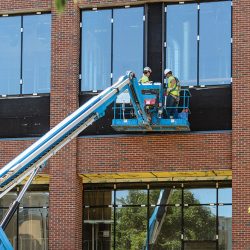Dissolving Borders

Window into a different world: Using a two-way video feed — and two languages — Michel Wattiaux’s dairy science class explores similarities and differences in dairy operations. Photo: Bryce Richter
Course puts distances aside to explore the dairy industries in Wisconsin and Mexico.
Michel Wattiaux PhD’90 must perform some major technological gymnastics during the hour before his students arrive. He tussles with the laptop, projector, and video-conferencing software needed to establish live, two-way video feeds with a handful of sister classrooms in Mexico. As each new link is made, he gives a wave and a quick “Hola. ¿Cómo estás?”
To Wattiaux, this extra effort is well worth it. By the time students start to breeze in, his Pyle Center conference room has been transformed into a truly international lecture hall, with dairy science professors and students from across Mexico in virtual attendance, projected on the large screen at the front of the room. Dairy Science 375: Evaluation of Dairy Agroecosystems in Wisconsin and Mexico is now in session.
“This class offers a window into a different world,” says Wattiaux, an associate professor of dairy science. “In this case, it’s Mexico and how Mexico is addressing the issue of sustainability in its dairy industry.”
Over the course of the semester, students in Wattiaux’s class learn about dairy operations in Mexico and Wisconsin, paying special attention to the sustainability of each type of system, including the economic, social, and environmental factors involved.
Wisconsin’s dairy industry is inextricably tied to Mexico’s and vice versa; many Wisconsin farmers rely on Mexican workers to milk their herds, while Mexican farmers value Wisconsin’s cows, dairy equipment, and services. For most lectures, Wattiaux, who earned tenure based on his innovative teaching, steps aside and lets experts from Mexico and UW-Madison share what they know directly with students. Topics vary widely from week to week — from manure runoff problems in the highlands of central Mexico to the nuts and bolts of organic operations in southwest Wisconsin.
“What’s really great about the class is we’re not just hearing from dairy scientists. We hear from economists and sociologists, too,” says graduate student Jennifer Blazek MAx’10. “So, all of these people are getting together to talk about a system, trying to figure out how it works, but not just from one perspective. We talk about the whole, big picture.”
Every idea voiced during these discussions is expressed twice — once in English and once in Spanish — so that monolingual students on both sides of the border can follow along. Lecturers speak in their native tongue in two- to three-sentence bites, and then pause to allow for translation. Although that slows things down, “the slower pace actually helps the ideas sink in,” says Wattiaux.
And he desperately wants them to sink in. Dairying is a promising way to raise rural Mexicans out of poverty, something Wattiaux feels passionately about because of his own experience. When he was eleven, his parents bought a forty-cow farm in Belgium. The farm struggled for years, inspiring Wattiaux to go to college to learn how to make it work.
For students who want to continue on, Wattiaux also teaches a spring seminar on dairying in Mexico and leads a summer field-study program in Mexico, where students conduct sustainability research on working dairy farms.
Those who make it all the way to Mexico will see some familiar faces: many of the Mexican experts featured in Wattiaux’s fall dairy agroecology course are also his research collaborators in that country.
“I always feel like we in Wisconsin are the greatest beneficiaries of this collaboration, but I’m hoping we can find ways to make this whole process as beneficial as possible to my Mexican collaborators, their students, and their universities,” says Wattiaux. “And as long as I perceive that they value this collaboration, I will continue to offer this class.”
Published in the Fall 2010 issue



Comments
No comments posted yet.